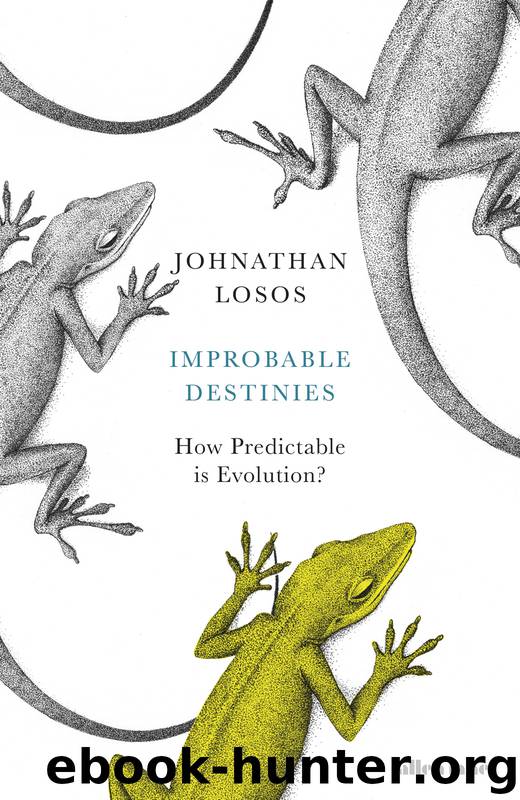Improbable Destinies by Jonathan Losos

Author:Jonathan Losos
Language: eng
Format: epub
ISBN: 9780241201947
Publisher: Penguin Books Ltd
Published: 2017-07-04T04:00:00+00:00
But, just as with Rothamsted pre-Snaydon, no one had bothered to ask whether evolution was occurring, whether plants within the exclosures were adapting to their very different environmental conditions. Then along came Marc Johnson, a Canadian evolutionary ecologist now on the faculty of the University of Toronto. Every few years, Silwood Park researchers had started new experiments while continuing to maintain the old ones. The result was a series of plots in which rabbits had been excluded for different lengths of time. Johnson latched onto these plots and made a double-barreled prediction: not only would plants adapt to the absence of grazing, but also the degree of adaptation would increase with the number of years rabbits had been excluded from a plot.
One of Johnson’s graduate students, Nash Turley, took the lead in the first part of the project. Turley looked at common sorrel, a slender herb sporting showy red flowers that is often grown for the tangy taste it imparts to a salad. Turley measured how rapidly the plants grew in the greenhouse and found a very strong trend: the longer a plot had been free of rabbits, the slower the plants grew. Over the course of a quarter century, growth rate evolved to be thirty percent slower in the absence of rabbits.
The success of that study led Johnson and Turley, with the assistance of stellar undergraduate Teresa Didiano, to examine other plant species. Three of the four species—all grasses—showed evidence of adaptation. For example, the number of leaves on red fescue decreased with the age of the exclosure. However, although three of the species had adapted to the lack of grazing, they did so in different ways, involving different traits. Moreover, the one forb, grass-leaf starwort, showed no consistent trend in any trait related to the age of the exclosures.
How you view the results of these studies depends on whether you’re a glass-half-empty or a glass-half-full kind of person. In the Silwood Park studies, populations of the same species mostly evolve in a predictable way in response to being released from grazing, predictable in the sense that the longer their freedom, the greater the extent of their adaptation to a rabbit-free lifestyle. But when compared across species, the way they adapted was not predictable—different species evolved in different ways in response to the same environmental conditions.
At about the same time that Johnson and others were retrofitting ecological experiments, evolutionary biologists finally began en masse to set up field experiments explicitly designed to study evolution. These studies are diverse and fascinating. For example, Marc Johnson and colleagues at Cornell grew evening primrose on plots on which plant-eating insects had been removed with insecticide. The eight populations of herbivore-free primroses evolved in the same way over a three-year period, flowering earlier and putting fewer defensive chemicals into their seeds compared to primroses on the buggy plots.
Other studies have looked at how worms adapt in artificial enclosures with warmer soil (simulating climate change) or whether insects will quickly evolve camouflaged patterns if placed in small plots with different types of vegetation.
Download
This site does not store any files on its server. We only index and link to content provided by other sites. Please contact the content providers to delete copyright contents if any and email us, we'll remove relevant links or contents immediately.
Sapiens: A Brief History of Humankind by Yuval Noah Harari(14322)
Sapiens by Yuval Noah Harari(5325)
Pale Blue Dot by Carl Sagan(4960)
Homo Deus: A Brief History of Tomorrow by Yuval Noah Harari(4873)
Livewired by David Eagleman(3730)
Origin Story: A Big History of Everything by David Christian(3666)
Brief Answers to the Big Questions by Stephen Hawking(3394)
Inferior by Angela Saini(3294)
Origin Story by David Christian(3170)
Signature in the Cell: DNA and the Evidence for Intelligent Design by Stephen C. Meyer(3103)
The Gene: An Intimate History by Siddhartha Mukherjee(3075)
The Evolution of Beauty by Richard O. Prum(2966)
Aliens by Jim Al-Khalili(2804)
How The Mind Works by Steven Pinker(2782)
A Short History of Nearly Everything by Bryson Bill(2666)
Sex at Dawn: The Prehistoric Origins of Modern Sexuality by Ryan Christopher(2500)
From Bacteria to Bach and Back by Daniel C. Dennett(2462)
Endless Forms Most Beautiful by Sean B. Carroll(2446)
Who We Are and How We Got Here by David Reich(2418)
